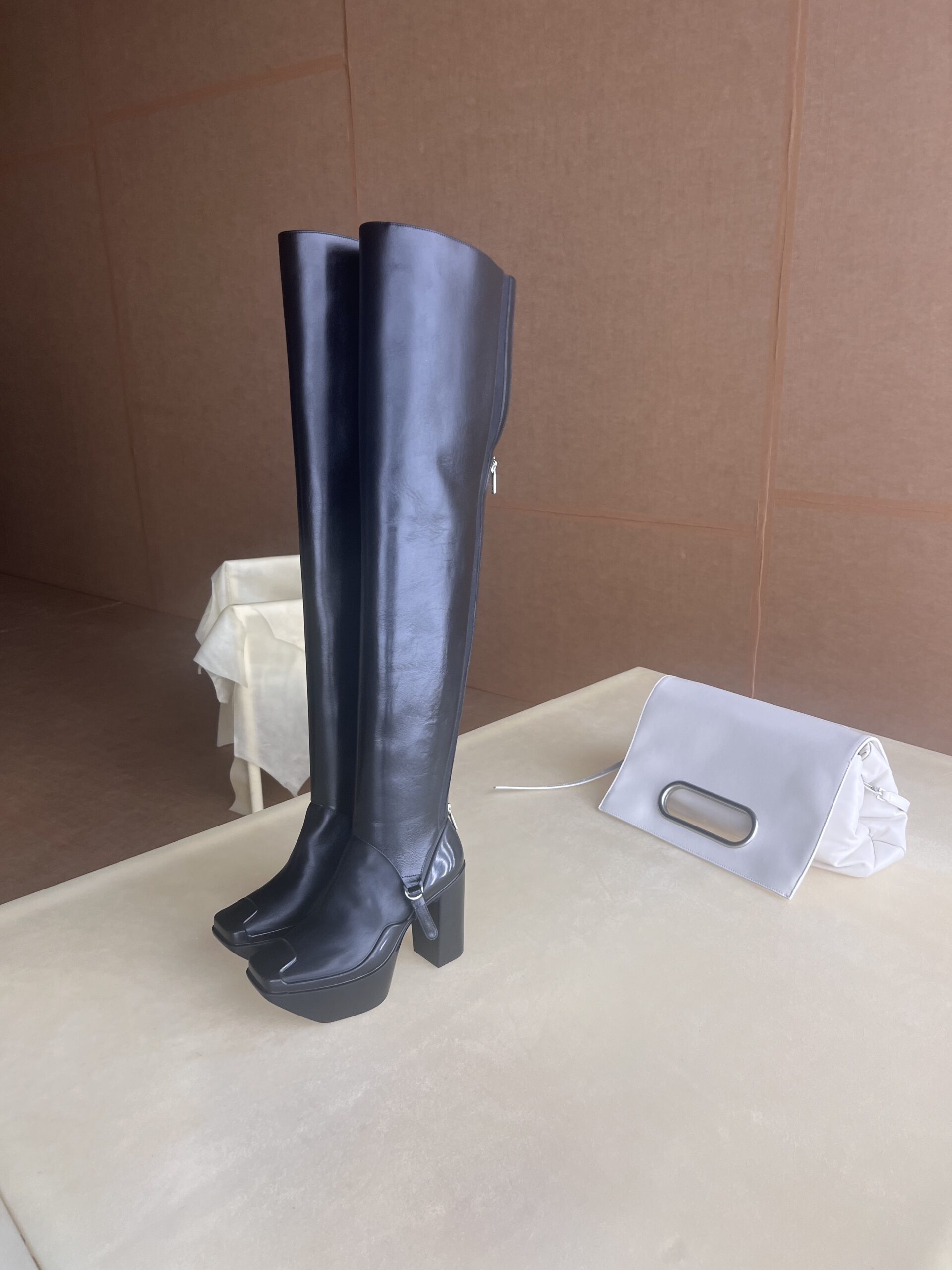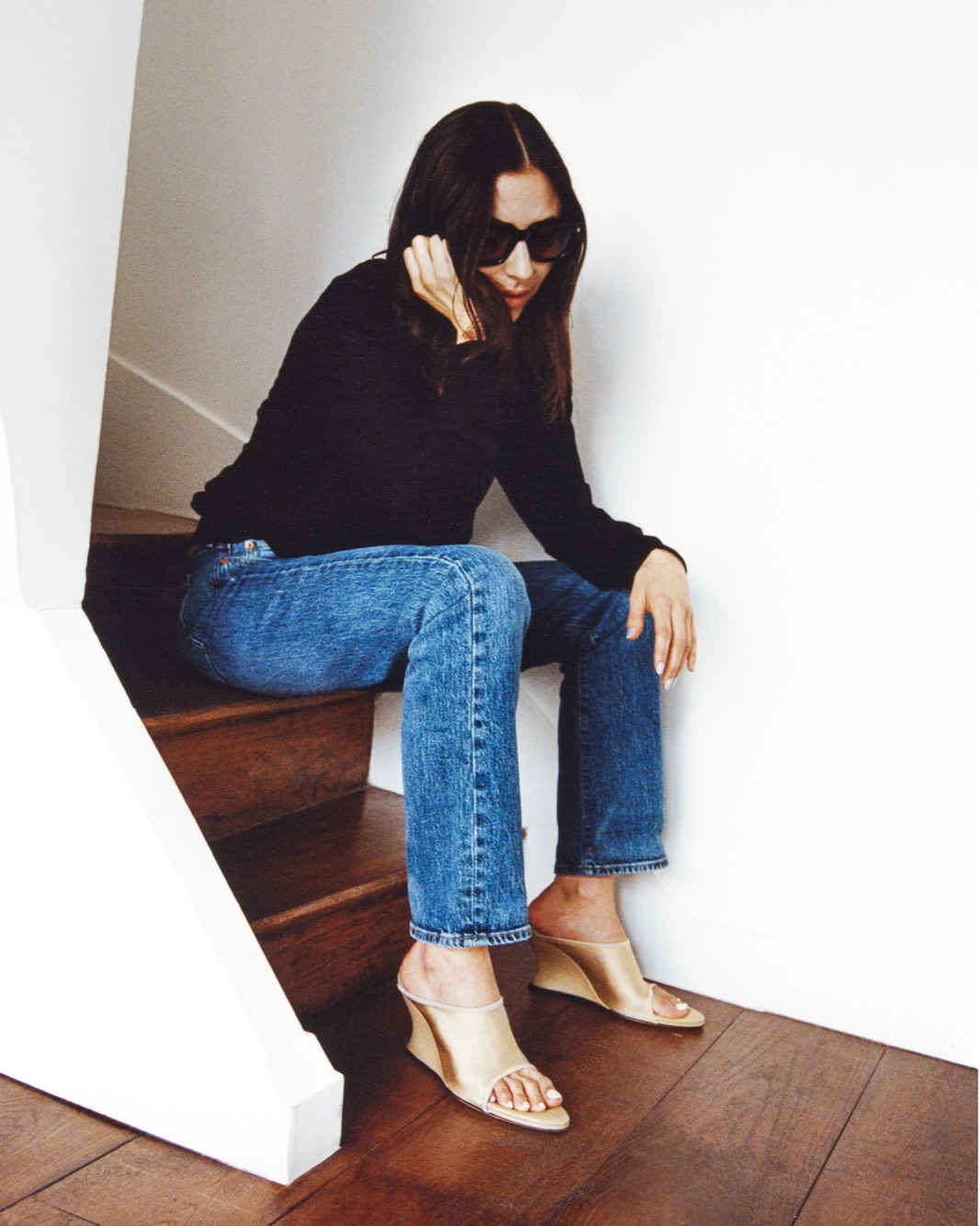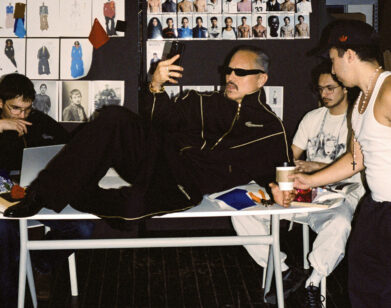MEN'S FASHION WEEK
Meet Nina Christen, Peter Do, and Kiko Kostadinov, At.Kollektive’s Newest Members

Last Saturday, in a brightly lit basement in the center of Dover Street Market’s Parisian compound, a series of eclectic leather garments and accessories were accented by cardboard walls and furniture finished with transparent leather hides designed by the architect Anne Holtrop. It was At.Kollektive’s third presentation, this time crafted by award-winning collaborators including shoe designer Nina Christen (Loewe), Kiko Kostadinov, and Peter Do. The company was founded by ECCO, a Netherlands-based tannery that provides materials for some of the world’s biggest luxury labels, with the intent of pushing innovation. “I like to think of At.Kollektive as being like a rock ’n’ roll supergroup,” says CEO Panos Mytaros. “You bring together these four talents and something extraordinary happens.” Below, we asked the designer’s behind At.Kollektive’s latest collaboration to tell us what inspired their revolutionary leather creations.
———
PETER DO

TAYLORE SCARABELLI: How’s your fashion week going?
PETER DO: It’s hectic [laughs]. When I’m here I’m in work mode, us New York gals.
SCARABELLI: I’m a little jet-lagged, to be honest with you. Ooh, it’s so cool down here.
DO: Yes!
SCARABELLI: Congratulations on your appointment at Helmut Lang, by the way. How does that feel?
DO: It’s been great. I’m just adjusting to having two jobs. It’s something you dream of doing for so long, since being a student, and now that it’s here it feels so surreal.
SCARABELLI: Are you nervous?
DO: I’m super nervous, but excited.
SCARABELLI: Doing collabs like this one for At.Kollektive must be good preparation.
DO: When I started PD [Peter Do], that was my transition from becoming a designer to a manager. I had my whole team, I had a business. For this project, I sort of just focused on being a designer again. There was a whole team that supported my vision. They’ve been so supportive of every crazy idea I have.
SCARABELLI: How did it start?
DO: They flew me to Amsterdam. The factory is about an hour’s ride away. I learned so much about how leather is made, where it comes from, different techniques. And I would come back from the factory after having a really creative process with the leather. And then we went back and forth for the next 12 months.
SCARABELLI: So what did we end up with here?
DO: So the objective for me was to continue the BD conversation with a modular wardrobe. I really wanted to do a sneaker, which is something I haven’t done before.
SCARABELLI: She’s a fancy sneaker.
DO: Exactly. But you can still walk in them.
SCARABELLI: It’s so light! And it looks so heavy duty from afar.
DO: She’s extra-padded.
SCARABELLI: Extra cozy. This is what I should be wearing. I keep wearing heels on the cobblestones and it’s not working.
DO: You need the platform version.

SCARABELLI: Okay I’m obsessed with these.
DO: We have a platform version like this for PD. But now these are the new hybrid version.
SCARABELLI: And this is removable, right?
DO: Yes. It’s a three-in-one shoe.
SCARABELLI: Which is good for fashion week. You can pack one shoe but then you have a couple options. It’s kind of giving horse girl with this stirrup. But a little fetish-y almost.
DO: [Laughs] This bag is cool also because you can take the top part off and it becomes another bag. Then it’s also a clutch. And the other piece becomes a tote bag.
SCARABELLI: So when you go shopping, you’re ready.
DO: Yes. [Laughs]
SCARABELLI: What’s this one called?
DO: The Pod Bag. It’s sort of inspired by the AirPod case.
SCARABELLI: It’s very tech-y. I need a bigger one because I have a giant granny phone.
DO: There’s a bigger one over there.
SCARABELLI: So cute. It fits everything you need for fashion week. Make-up, a power bar.
DO: Two phones.
SCARABELLI: Just kidding I’m not eating. [Laughs] You know the vibes.
———
NINA CHRISTEN

only women should design shoes for women.

SCARABELLI: It’s a flattering color. So, you normally work with other brands. Is this the first time you kind of did your own footwear collection?
———
KIKO KOSTANDINOV

TAYLORE SCARABELLI: Congratulations on your show. How are you feeling?
KIKO KOSTANDINOV: I haven’t slept much. But after this, I’m going to rest because I have a party tonight.
SCARABELLI: Will you get a little vacation after?
KOSTANDINOV: I’m going to Japan and Korea, and then I will be going to America for a bit—then maybe a holiday. But women’s is just around the corner, so we’ll see.
SCARABELLI: There’s never a time-out. But the collection looked great, so I think it’s all worth it.
KOSTANDINOV: Have you seen the pieces here? We have footwear, this is the sole that we developed looking at ECCO’s archives in Denmark. It’s very 90s and 2000s. This one is like a slip on and then you have the version which is more of a complete shoe.
SCARABELLI: It’s almost like fabric, right?
KOSTANDINOV: Yeah. And it’s bonded with bamboo. I wanted the feeling of a slipper—you can wear it at home, you can wear it to a meeting, you can wear it on a plane. It’s kind of a complete idea of a collection that you can travel with on a long weekend. You have the bookbag, the laptop bag which is very thin, and then shoes you can travel with.
SCARABELLI: So you were thinking about yourself and all the traveling you have to do this summer. Are you a light packer?
KOSTANDINOV: I try to be but I think the more you travel the more you just make it work.
SCARABELLI: What do you put in here? Maybe a little bottle of wine or something.
KOSTANDINOV: Yeah. You can even put it on your belt loop as well.
SCARABELLI: She’s versatile.
KOSTANDINOV: Exactly. And then you can have this little chain.
SCARABELLI: Oh cute, it’s like a purse.
KOSTANDINOV: It could be anything.
SCARABELLI: How do you feel approaching accessories versus clothing?
KOSTANDINOV: It’s really been amazing to work with a company that can do it. I was like, “Wow I wish I could have this team too.” The leathers are out of the world, of course, but then they have the workshops in the factory to do all the little details.
SCARABELLI: They’re quick, right?
KOSTANDINOV: Yeah, quick but very considered. Even this kind of binding—the leather is hand-cut. So it’s very artisanal.
SCARABELLI: I really like the colors.
KOSTANDINOV: Yeah, I really needed to push the colors because when you see the leathers you’re like, “Oh, wow.” They supply all the leather for LVMH, Kering. Even my iPhone case is made by them, so I really want to do something very lux. The brief was to really push what leather could be rather than just pick all the best leather they have and make an expensive bag. So it’s been really fun. For the clothes we combined twill, cotton, and leather to make it a bit more in line with what I do, but also a full leather outfit. Leather is a bit hardcore for me, so I tried to find balance with the stripes.
SCARABELLI: You like to be a little more playful and not so—
KOSTANDINOV: If I can’t really wear it, I don’t really want to design it. But everything’s a really good price.
SCARABELLI: Really?
KOSTANDINOV: Yeah. I really was very adamant about keeping the price accessible for what it is.
SCARABELLI: Are you like that with your brand as well?
KOSTANDINOV: Yeah. I just want people to buy it and feel like they’re getting something. I mean, if it’s like a hand technique, then you can really push the price, but it’s not a luxury brand like Hermes or Vuitton.
SCARABELLI: Would you ever work for a brand like that or do you just want to do your own thing?
KOSTANDINOV: Just my own thing for now. But working for someone else is cool—especially when you get to play with their money and resources.
SCARABELLI: But on your own terms.
KOSTANDINOV: Exactly. Maybe when the time comes.







